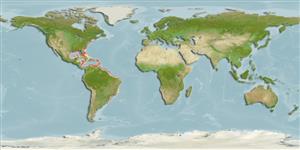Environment: milieu / climate zone / depth range / distribution range
पारिस्थितिकी
समुद्री बाथीड़िमरसल; गहराई सीमा 360 - 735 m (Ref. 31632). Deep-water
Western Central Atlantic: Gulf of Mexico and the Caribbean Sea.
आकार / वज़न / Age
Maturity: Lm ? range ? - ? cm
Max length : 25.8 cm TL पुल्लिंग / अलिंग; (Ref. 115012); अधिकतम प्रकाशित वज़न: 149.00 g (Ref. 115012)
Short description
आकृति विज्ञान | मौरफोमैटरिक्स
पृष्ठीय रीढ़ (सम्पूर्ण): 7; पृष्ठीय सौफट रेज़ (सम्पूर्ण): 10. Well-developed opercular spines present. Distance between the anal opening and the beginning of the anal fin is 41-55 percent of the distance between the base of the pelvic fin and the anal opening (Ref. 31632).
A mesobenthic-pelagic species living mainly above the bottom (Ref. 31632).
Life cycle and mating behavior
परिपक्व अवधि | पुनरुत्पत्ति | मछलीऔ का अंडे देना | अंडे | Fecundity | लार्वा
Abramov, A.A., 1992. Species composition and distribution of Epigonus (Epigonidae) in the world ocean. J. Ichthyol. 32(5):94-108. (Ref. 31632)
IUCN Red List Status (Ref. 130435)
Threat to humans
Harmless
Human uses
अधिक जानकारी
आम नामउपशब्दचपायचयपरभक्षीईकोटोकसीकोलौजीपुनरुत्पत्तिपरिपक्व अवधिमछलीऔ का अंडे देनाSpawning aggregationFecundityअंडेEgg development
संदर्भजलीयकृषिजलीयकृषि रूपरेखाखींचआनुवंशिकीElectrophoresesहैरेटिबिलटीबीमारीप्रक्रमणNutrientsMass conversion
सहयोगीयोतस्वीरेStamps, Coins Misc.ध्वनिसिगुयटिरारफ्तारतैरने के प्रकारगिल क्षेत्रOtolithsदिमागदृष्टि
साधन
Special reports
Download XML
इंटरनेट स्रोत
Estimates based on models
Preferred temperature (Ref.
123201): 8.3 - 14.4, mean 10.9 °C (based on 71 cells).
Phylogenetic diversity index (Ref.
82804): PD
50 = 0.5000 [Uniqueness, from 0.5 = low to 2.0 = high].
Bayesian length-weight: a=0.00724 (0.00371 - 0.01413), b=3.08 (2.90 - 3.26), in cm total length, based on LWR estimates for this species & (Sub)family-body (Ref.
93245).
Trophic level (Ref.
69278): 3.5 ±0.5 se; based on size and trophs of closest relatives
लौटाव (Ref.
120179): माध्यम, न्यूनतम जनसंख्या दुगनी होने का समय 1.4 - 4.4 वर्ष। (Preliminary K or Fecundity.).
Fishing Vulnerability (Ref.
59153): Low vulnerability (16 of 100).
